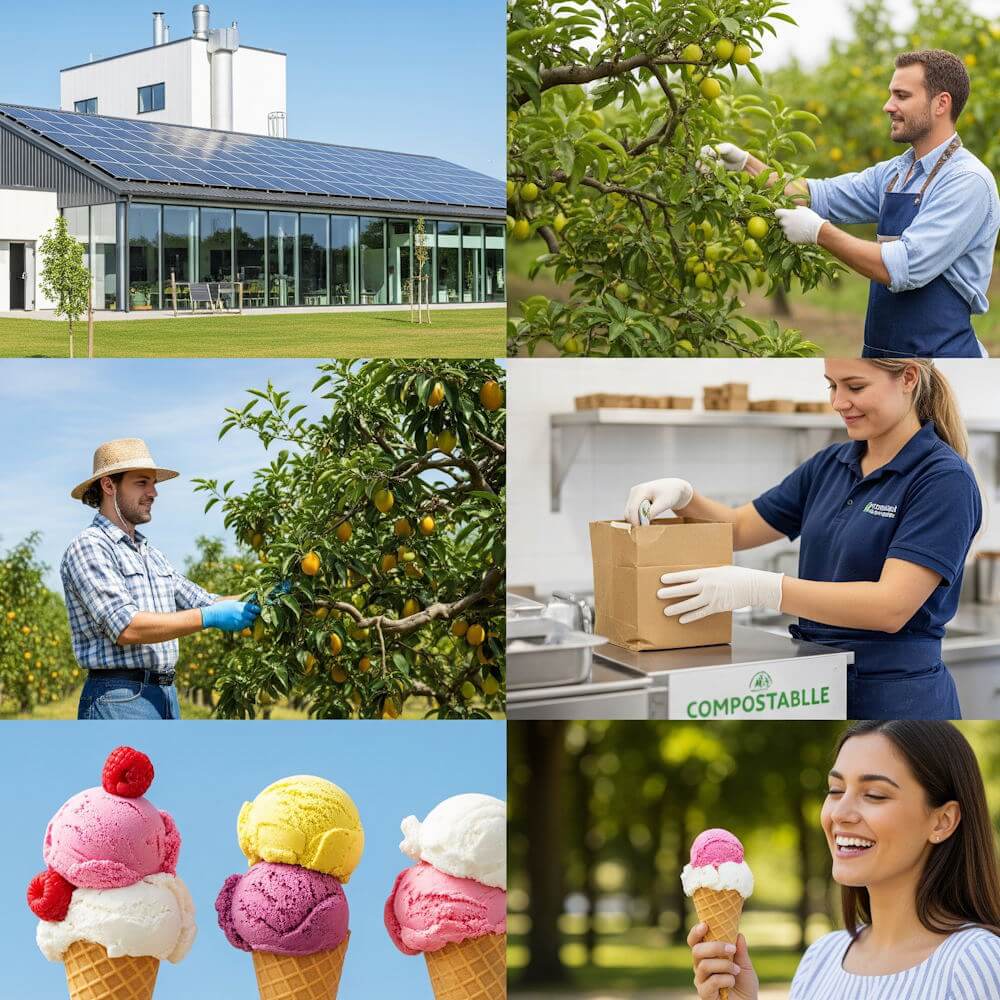Introduction to Sustainability in Ice Cream
Sustainability in the ice cream industry refers to the approach of producing and consuming ice cream in ways that minimize environmental impact while promoting social equity and economic viability. This concept encompasses various aspects, including the sourcing of ingredients, production processes, packaging, and waste management. As a beloved global treat, ice cream carries the responsibility of addressing the environmental and societal challenges associated with its production and consumption.
The importance of sustainability in ice cream production cannot be overstated. The ice cream industry directly affects numerous environmental aspects, such as water usage, greenhouse gas emissions, and waste generation. The sourcing of key ingredients, like dairy and sweeteners, often involves practices that can lead to soil degradation, depletion of natural resources, and negative effects on local ecosystems. Consequently, transitioning towards sustainable production methods is crucial to mitigate these impacts. This transition not only aims to protect the environment but also to support local farmers and communities, ensuring fair labor practices and equitable economic benefits.
Moreover, as consumer awareness of environmental and social issues grows, there is increasing demand for sustainably produced products, including ice cream. This shift in consumer preference encourages ice cream manufacturers to adopt sustainable practices in order to maintain competitiveness in the market. By embracing sustainability, companies can enhance their brand loyalty and improve their overall market position. Thus, understanding the significance of sustainability is vital for stakeholders across the ice cream industry, from producers to consumers.
In summary, establishing sustainable practices within the ice cream sector is essential, not only for preserving the planet but also for fostering economic and social sustainability. The interconnectedness of these factors highlights the need for holistic approaches to production and consumption that prioritize the future of our food systems.
The Environmental Impact of Ice Cream Production
The production of ice cream, while enjoyed by many, has significant environmental consequences that cannot be overlooked. Traditional methods of manufacturing ice cream contribute considerably to the industry’s carbon footprint, largely due to the energy-intensive processes involved in creating and refrigerating the final product. Studies indicate that the dairy sector accounts for approximately 3.5% of global greenhouse gas emissions, with ice cream being a notable contributor within this category. These emissions stem from various sources, including methane released by dairy cows and energy consumption during processing and distribution.
Water usage is another critical concern in ice cream production. The dairy industry requires a substantial amount of water for the rearing of cows, as well as for processing milk into ice cream. On average, it takes about 1,000 liters of water to produce just one liter of milk, highlighting the extensive water footprint of the dairy sector. Additionally, the ice cream manufacturing process itself, which often involves mixing various ingredients and ensuring a smooth texture, further adds to water consumption. The growing recognition of this environmental challenge necessitates a shift towards more sustainable practices.
Moreover, waste generation poses a pressing issue. Traditional packaging materials, primarily single-use plastics, contribute significantly to environmental degradation. The disposal of these materials often leads to pollution in landfills, oceans, and other natural habitats. Recent statistics reveal that consumers discard approximately 8 million tons of plastic waste each year, emphasizing the need for the ice cream industry to adopt sustainable packaging solutions. These environmental impacts highlight the urgent requirement for manufacturers to evaluate their practices, embrace sustainability, and consider the broader implications of ice cream production on the planet. Addressing these challenges is essential to fostering a more sustainable and environmentally friendly ice cream industry.
Sourcing Ingredients Sustainably
The sourcing of ingredients in the ice cream industry plays a crucial role in promoting sustainability and reducing the overall environmental impact. Central to this process is the practice of sustainable farming, which involves methods that protect the ecosystem while ensuring viable crop production. For ice cream, key ingredients include dairy, sugars, and flavorings, all of which can be sourced in a manner that is both environmentally and socially responsible.
One of the primary components of ice cream is dairy, and sourcing it from farms that utilize sustainable practices is essential. This includes supporting local dairy farms that employ animal welfare standards and sustainable feed practices. Implementing rotational grazing and reducing the use of antibiotics are strategies that help maintain healthy soil and water resources. Furthermore, fair trade sourcing ensures that dairy farmers are compensated fairly, fostering economic equity and sustainability in local communities.
Sugars and flavorings also warrant careful consideration regarding their origins. Opting for organic sugars eliminates the need for harmful pesticides and fertilizers, mitigating soil degradation and water pollution. Additionally, seasonal ingredients can significantly reduce the environmental footprint associated with transportation and storage, as they are more likely to be cultivated closer to the processing facilities. Supporting local farmers’ markets or community-supported agriculture (CSA) programs can also lead to fresher, more flavorful ice cream while contributing to regional economies.
Incorporating these sustainable sourcing practices allows ice cream manufacturers to not only reduce their environmental impact but also serve as advocates for responsible consumer choices. By prioritizing sustainable ingredients, the ice cream industry can contribute to a broader movement towards sustainability, where ethical sourcing supports both the planet and the communities involved in food production.
Packaging Innovations in the Ice Cream Industry
The packaging used in the ice cream industry plays a crucial role in ensuring the sustainability of the entire sector. Traditional packaging methods often rely heavily on plastics, which contribute significantly to environmental pollution and fail to break down in natural ecosystems. In contrast, the trend towards eco-friendly packaging has gained momentum, driven by increasing consumer awareness about sustainability and a growing demand for environmentally responsible products. Consumers are now more inclined to support brands that prioritize sustainable practices, making packaging innovations essential to remain competitive.
Eco-friendly packaging options encompass a range of materials designed to minimize environmental impact. Biodegradable materials, such as those derived from plant-based sources, are emerging as promising alternatives to conventional plastic. These materials are engineered to break down naturally, reducing landfill contributions and lessening carbon footprints. Packaging made from recycled paper and cardboard is also increasingly popular, as it provides an effective solution while promoting a circular economy. Manufacturers are experimenting with various innovations, including coatings that enhance moisture resistance while still maintaining recyclability. Such advancements not only satisfy environmental considerations but also ensure product integrity, which is essential for preserving the quality of ice cream.
One of the key factors influencing consumer opinions on sustainable packaging is the ability to recycle. Consumers actively look for clear recycling information and instructions on packaging labels, as they wish to contribute to sustainability by making informed choices. Brands that embrace transparency regarding the recyclability of their packaging often enjoy stronger loyalty from their customers. Moreover, innovative designs that attract attention while communicating sustainability benefits have shown potential in swaying consumer preferences. As the ice cream industry continues to evolve, it will be imperative to integrate sustainable packaging practices that meet both ecological goals and consumer expectations.
The Role of Consumer Awareness and Behavior
Consumer awareness plays a vital role in shaping the sustainability practices within the ice cream industry. As knowledge about environmental issues and climate change increases, consumers are becoming more discerning about the products they purchase. They now opt for brands that demonstrate a commitment to sustainability, prompting a significant shift in industry practices. This change is primarily driven by the demand for products that are not only delicious but also responsibly sourced and eco-friendly.
Recent studies indicate that a growing number of consumers prioritize sustainability when making purchasing decisions. Surveys reveal that up to 70% of individuals are willing to pay a premium for sustainably produced ice cream, which includes organic ingredients, eco-friendly packaging, and fair trade practices. This willingness has galvanized companies within the industry to adapt their operations, leading to the promotion of sustainable sourcing, ethical labor practices, and reduced carbon footprints.
Moreover, successful case studies illustrate how consumer choices can catalyze change. For instance, big brands such as Ben & Jerry’s have integrated sustainability into their core values, driven largely by consumer demand for ethical products. This has resulted in the company not only sourcing fair trade ingredients but also advocating for environmental and social justice initiatives. Smaller artisanal ice cream brands have also emerged, focusing on local ingredients and eco-conscious techniques. These businesses have found success by appealing to consumers who value transparency and responsibility in their food choices.
As consumers become more engaged with their purchasing habits, their influence on the ice cream market cannot be overstated. The drive for sustainability is no longer a mere trend but is quickly becoming a central tenet of consumer behavior. As this awareness continues to grow, the industry will likely face pressure to evolve further, creating a more sustainable future for ice cream production.
Corporate Responsibility and Sustainability Initiatives
The ice cream industry, known for its indulgent treats, is increasingly becoming aware of its environmental responsibilities. As consumer awareness surrounding sustainability grows, major ice cream brands are proactively implementing initiatives aimed at reducing their ecological footprint. These corporate responsibility programs encompass a wide range of practices designed to improve energy efficiency, reduce waste, and engage local communities in sustainability efforts.
A noteworthy example is Ben & Jerry’s, which has long been recognized for its commitment to environmental sustainability. The company has adopted a comprehensive approach by sourcing ingredients from Fairtrade-certified suppliers, thereby supporting sustainable farming practices. In addition, Ben & Jerry’s has committed to reducing greenhouse gas emissions in its manufacturing processes and has promoted the use of non-dairy alternatives to appeal to a wider audience, while also lessening the environmental impact of dairy farming.
Another significant player, Haagen-Dazs, has set ambitious targets to enhance sustainability across its operations. This includes a commitment to use 100% recyclable or reusable packaging by 2025. The brand has also taken steps to reduce water usage in its production facilities and has invested in energy-efficient technologies to minimize its carbon footprint. Moreover, Haagen-Dazs has engaged in community outreach initiatives, such as collaborations with local farmers to promote sustainable cultivation practices and biodiversity.
Furthermore, Häagen-Dazs champions sustainability through its “Dairy with Dignity” program, which focuses on ethical sourcing and the welfare of dairy cows. This initiative not only fosters responsible farming but also addresses consumer demands for transparency and ethical production. The efforts made by these brands illustrate a growing recognition of the importance of sustainability in the ice cream industry and highlight the tangible actions that can be taken to address environmental challenges.
Challenges and Barriers to Sustainability
The ice cream industry, while increasingly aware of the importance of sustainability, faces multiple challenges and barriers that complicate its path towards environmentally friendly practices. One of the most significant obstacles is the cost implications associated with implementing sustainable methods. Transitioning to organic ingredients, environmentally friendly packaging materials, and energy-efficient production processes often requires substantial investment. For many small to medium-sized producers, these financial burdens can be daunting, potentially leading to reluctance in adopting more sustainable practices.
Furthermore, inconsistencies in consumer demand pose an additional barrier to sustainability. While a segment of the market is indeed driving demand for eco-conscious products, there remains a considerable portion of consumers who prioritize cost and convenience over sustainability. This disparity can create confusion for manufacturers who strive to align their products with sustainable principles but struggle to meet the diverse expectations of their customer base. In turn, this inconsistency may discourage businesses from fully committing to sustainable development strategies.
Another critical factor impacting sustainability in the ice cream sector is the scalability of green practices. While some larger companies may find it easier to incorporate sustainable methods due to their resources, smaller enterprises often lack the capacity to implement similar initiatives at a comparable scale. The complexities of supply chain logistics also present challenges, as sustainable sourcing and distribution require robust frameworks that are not easily accessible to all players within the industry.
Ultimately, while the ice cream industry is making strides towards sustainability, significant challenges and barriers remain. Addressing these obstacles requires collaboration among industry stakeholders, innovation in sustainable practices, and a commitment to shifting consumer perceptions towards more eco-friendly alternatives.
Future Trends in Sustainable Ice Cream Production
The ice cream industry is undergoing a significant transformation as sustainability becomes increasingly essential to consumer preferences and environmental considerations. One prominent trend is the rise of plant-based ice creams. As consumers look for healthier options and seek to reduce their economic and environmental footprint, dairy alternatives made from ingredients like almond, coconut, and oat milk are gaining traction. This shift not only caters to those with lactose intolerance or dairy allergies but also appeals to environmentally conscious consumers who opt for plant-based products due to their lower carbon emissions compared to traditional dairy ice creams.
Technological innovations are also paving the way for sustainable production practices. Production facilities are harnessing advanced technologies, such as machine learning and automation, to enhance efficiency in ingredient sourcing and minimize waste. These innovations can lead to reduced energy consumption and lower operational costs, ultimately contributing to a smaller ecological footprint. Moreover, the direct tracking of supply chains powered by blockchain technology ensures transparency regarding the sourcing of raw materials, thereby promoting ethical practices within the ice cream industry.
The future landscape of sustainable ice cream production will likely be influenced by shifting consumer preferences that prioritize sustainability. As more consumers become conscious of their choices, they are expected to favor brands that actively reduce their environmental impact. This change may be coupled with regulatory shifts that encourage manufacturers to adopt eco-friendly practices, such as reducing single-use plastics in packaging or sourcing coconut and almond suppliers with a focus on sustainable farming. Ultimately, the convergence of consumer demand, technological advancements, and regulatory frameworks will define the future of sustainability in ice cream production, leading to a more responsible industry that resonates with the values of today’s eco-conscious consumers.
Conclusion: The Importance of Sustainable Choices
As the ice cream industry continues to flourish, the urgency for sustainable practices grows increasingly critical. The choices made today regarding sourcing ingredients, production processes, and packaging not only influence the quality and appeal of ice cream products but also carry significant implications for the environment. Sustainable practices can lead to reduced waste, lower carbon footprints, and a more responsible use of natural resources. This is essential for ensuring that future generations have access to both ice cream and a healthy planet.
Consumers play a vital role in this transition towards sustainability. By choosing brands that prioritize eco-friendly methods, they support an industry shift that values environmental stewardship. The demand for sustainable ice cream options can encourage manufacturers to adopt greener practices, thereby promoting ecological responsibility. Furthermore, customers who advocate for sustainable products help raise awareness of environmental issues, fostering a culture of sustainability that extends beyond just ice cream to all aspects of food production.
On the other hand, industry players must acknowledge and commit to their responsibility in creating a sustainable future. By investing in sustainable technologies and practices, they can significantly mitigate their impact on global issues such as climate change and biodiversity loss. This involves evaluating and refining supply chains, seeking out ethically sourced ingredients, and engaging in innovations that reduce waste and improve energy efficiency. The shift toward sustainability is not merely an option; it is a necessity for the long-term viability of the ice cream sector and the broader ecosystem.
In conclusion, the integration of sustainable choices in the ice cream industry is paramount for safeguarding the environment, supporting communities, and ensuring economic resilience. Both consumers and industry leaders must work collaboratively to foster a sustainable future, ensuring that the joy of enjoying ice cream can continue without compromising the health of our planet.





